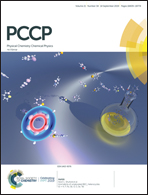A proton transfer mechanism along the PO4 anion chain in the [Zn(HPO4)(H2PO4)]2− coordination polymer†
Abstract
In this study, we revisit the proton transfer mechanism in [Zn(HPO4)(H2PO4)]2−, a coordination polymer possessing high proton conductivity. In a previous report [N. Phattharasupakun, J. Wutthiprom, S. Kaenket, Th. Maihom, J. Limtrakul, M. Probst, S. S. Nagarkar, S. Horike and M. Sawangphruk, Chem. Commun., 2017, 53, 11786–11789], it was hypothesized that protons could move along the ImH+ chain involving phosphate anions within the polymer structure, with energy barriers >1.3 eV. Adopting M06-2X calculations to examine the reaction pathway, we observe that it is much more favorable for H+ to move along a one-dimensional channel formed by HPO42− and H2PO4− anions. Within a unit cell, the proton hopping process can be divided into three elementary steps. For the forward proton transfer direction, the maximum energy barrier is only 0.04 eV, while that of the backward direction is 0.27 eV. Even though the barriers of the backward direction seem to outreach the barriers of the forward direction, both are still low in comparison with those reported in the literature. Moreover, we also point out the involvement of PO4 rotation during the proton transfer process. Activation energies of 0.37 eV and 0.15 eV are required for single steps of rotation of the phosphate anion. Both H+ translation (hopping) and rotation steps of PO4 anions simultaneously participate in the course of proton transfer in the coordination polymer.
![Graphical abstract: A proton transfer mechanism along the PO4 anion chain in the [Zn(HPO4)(H2PO4)]2− coordination polymer](/en/Image/Get?imageInfo.ImageType=GA&imageInfo.ImageIdentifier.ManuscriptID=C9CP04216D&imageInfo.ImageIdentifier.Year=2019)


 Please wait while we load your content...
Please wait while we load your content...